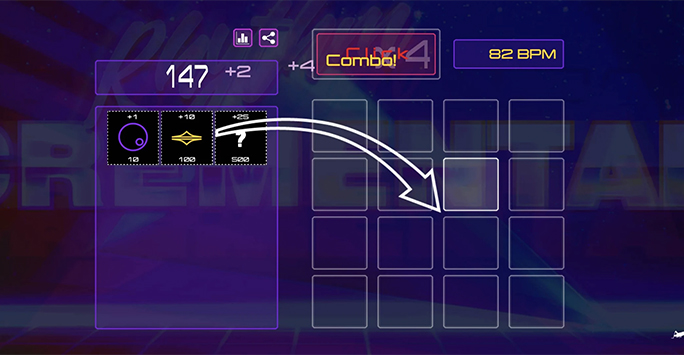Background
Many musical games take the form of ‘rhythm games,’ where player goals are to follow performance instructions as precisely as possible. Examples of these games include popular titles such as Rock Band, Guitar Hero, Space Channel 5, and Parappa the Rapper. These games do not offer many, if any, affordances for creative music-making. The possibilities mostly consist of whether or not the performance instructions are followed in a timely manner. In contrast, games such as Sound Shapes, Panoramical, and Proteus give players varying degrees of agency in crafting how the musical works unfold. In these games, the player explores a limited possibility space of composition, where decisions have an impact on the resulting music beyond a success-failure binary.
Rhythmcremental draws inspiration from these games, and offers users a range of compositional possibilities using the framework of an ‘incremental’ or ‘clicker’ game. Cookie Clicker (http://orteil.dashnet.org/cookieclicker/) by Orteil serves as a prototypical example of the genre. At the start of the game players click on a giant cookie icon, generating a cookie with each click. Once fifteen cookies have been generated, those cookies can be used to buy a cursor—a hand that automatically clicks on the cookie every ten seconds. Multiple cursors can be purchased (with the price incrementing each time), speeding up production. 100 cookies can be traded in for a grandma, which generates one cookie per second. This process continues with cookie-generators becoming more and more expensive while generating more and more cookies per second.
The project
Rhythmcremental uses the same basic gameplay mechanic as Cookie Clicker, but replaces the cursors and grandmas with sounds that are laid out across a 16-beat sequencer. While it features rhythmic pattern matching (clicking in time increases the point multiplier), incremental progression (more items become available over time) and statistical analysis, the game is primarily concerned with musical authorship—i.e. the creation of unique patterns and arrangements.
Initially, players click the ‘Click’ box to gain points. Points are then used to buy items which can be dragged from the inventory on the left of the screen into the grid on the right. Items in the grid—i.e. classic drum machine sounds, including kick drum, hi-hat, snare, chords, bass, and melody—add more points as they are triggered sequentially.
By way of its design, Rhythmcremental places additional limitations, beyond those of a traditional sequencer, on the player/composer, inasmuch as each addition to the sequence must be purchased with points. In other words, player decisions may be affected by considerations of profitability (in terms of raising the speed of point acquisition) as well as the player/composer’s musical goals.
Sonically, the player’s choices are limited by the available sound set as well as the algorithmic decisions of the “chords” item. The player/composer cannot choose which chord they are adding, only the location of that chord. Based on that chord’s location (and the location of other chord objects) it will have a different root and quality. The algorithm is designed to limit the compositional possibilities to those that sound “good” (or at least fall into the realm of a certain aesthetic). The bassline and melody are then determined by the placement of the sounds in relation to the current chord progression. Just as there are limitations in the possible chord progressions, there are limitations in the basslines and melodies that can occur with a chord progression. Considered, with 16 sequencer slots that can either contain a chord or not, there are 2^16 = 65,536 possible chord progressions. The bass part, too, would have the same number of possibilities, 65,536, but combined, the bass and chords offer 65,536 x 65,536—over 4 billion different possibilities. The possible sequences using all six instrument sounds is 65,536^6 = about 8 x 10^28. The range of possibilities is not infinite, but certainly sufficiently broad that one would have to spend a great deal of time exploring them all.
Accessibility was also a primary consideration in the design of Rhythmcremental. The controls are simple (click and drag). While there is a large field of musical possibilities, the materials are arranged so that consonant melodic/harmonic relationships can be generated without requiring an understanding of the underlying musical theory. It is freely available in multiple formats, including HTML5, Android, and iOS versions. Additionally, unique codes are generated for all musical patterns to facilitate saving and sharing.
Outcomes
The project has been released publicly on multiple platforms, including HTML5, Android and iOS.
HTML5: https://batta.itch.io/rhythmcremental
Android: https://play.google.com/store/apps/details?id=com.Batta.Rhythmcremental
iOS: https://apps.apple.com/app/id1436397186
Simon Hutchinson: https://simonhutchinson.com/
Paul Turowski: http://paulturowski.com/
Back to: Department of Music
